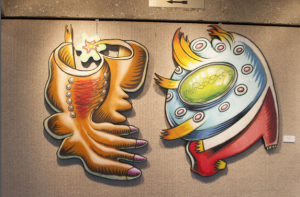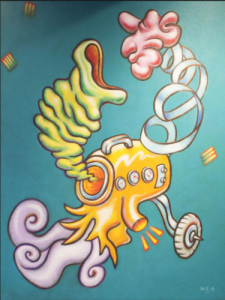Diminishing Boundaries
EAST PEORIA — The Illinois Central College Performing Arts Center is currently displaying a pop-surrealist collection by Peoria’s William Butler. Butler is a local artist from Bartonville, IL. He is primarily a painter but attended school for graphic design and illustration, earning his Bachelors in Arts from Northern Illinois University, and an Associates in Arts and Sciences right here at Illinois Central College. Butler is instrumental in Peoria’s art scene expansion, known most notably for his work as executive director at the Contemporary Art Center in downtown Peoria.

LAUREN MARRETT | THE HARBINGER
He describes his work as “Pop-Surrealism,” a relatively uncommon art genre that is still being defined today. Also known as “Lowbrow art,” this form fuses pop art’s bold, colorful visual allure with surreal art’s illogical and compelling statement. As Butler puts it, he is “going for a surrealist approach with a pop art sensibility.” He cites fellow pop- surrealists Tim Biskup, Camille Rose Garcia, and Mike Giantas influences, all of whom have the same unconventional idea of their particular genres. A direct cause of Butler’s end-result in particular is in his equally unconventional process to get there.
“I channel stuff from my subconscious like comic book imagery, logos, typography and block printing,” he said of his beginning process, “this kind of stuff is what I’ll doodle.” According to Butler, most of his work is the result of “absent minded pencil doodles, which he soundly describes “purposeful.” These unplanned drawings are enlarged and developed into color studies, and eventually are painted with acrylic on canvas or on a cut-out slab of wood.
His chief piece in the P.A.C. gallery “BoBo Loves Miss Vishni” shows the surreal side of Butler’s paintings, and exemplifies his craft creativity. Painted with colorful acrylic on two wood boards, it shows the random inspiration and succeeds at being obscure, yet presents itself easily for the viewer. It’s easy to look at, easy to interpret, but nearly impossible to understand. Even Butler, working from initial doodles, doesn’t know exactly what he means by it. “I don’t want to define for the viewer what it is that they are looking at exactly” he said, “ I want the viewer’s imagination to be engaged to draw their own conclusions about what it is that they are seeing.”

LAUREN MARRETT | THE HARBINGER
For this piece in particular, Butler used his “diminish the boundary” method, eliminating the frame and creating a hybrid painting/wall sculpture. By not allowing the imagery to “be cut off by the picture plane” or to “allow the characters to be defined” by space, Butler leaves even more room for interpretation of his abstract “BoBo,” among many other hybrid works.
Another work, “Confrontation in a Vacuum,” follows the lowbrow, abstract model, but works more conventionally with its defined space and its simplicity. One can see Butler’s inner-Seuss in this work, and, with the explanatory title, it is more eligible of proper interpretation. While being easier to understand and more conventional, though, its nature follows suit with the rest of Butler’s paintings and works very well among the pieces.
These and other William Butler works are on displayinthePerforming Arts Center gallery until mid-March. Gallery hours are 9:00a.m. – 9:00p.m. Monday through Thursday and 9:00a.m. – 4:00p.m. on Fridays.

